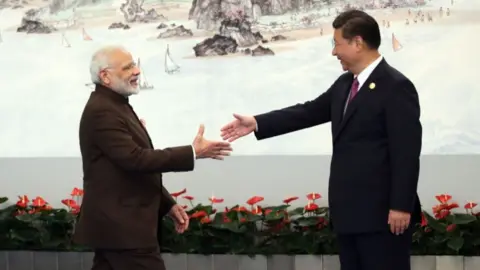India's Prime Minister Narendra Modi landed in China on Sunday with the sting of Donald Trump's US tariffs still top of mind. Since Wednesday, tariffs on Indian goods bound for the US, like diamonds and prawns, now stand at 50% – which the US president says is punishment for Delhi's continued purchase of Russian oil.
Experts say the levies threaten to leave lasting bruises on India's vibrant export sector, and its ambitious growth targets. China's Xi Jinping, too, is trying to revive a sluggish Chinese economy at a time when sky-high US tariffs threaten to derail his plans.
Against this backdrop, the leaders of the world's two most populous countries may both be looking for a reset in their relationship, which has previously been marked by mistrust, much of it driven by border disputes.
Put simply, what happens in this relationship matters to the rest of the world, wrote Chietigj Bajpaee and Yu Jie of Chatham House in a recent editorial.
India and China are economic powerhouses – the world's fifth and second largest, respectively. With India's growth expected to remain above 6%, a $4tn economy, and a $5tn stock market, it is on the way to moving up to third place by 2028, according to the International Monetary Fund (IMF).
However, the two sides have an unresolved and long-standing territorial dispute – that signifies a much broader and deeper rivalry. Violence erupted across Ladakh's Galwan Valley in June 2020 – the worst period of hostility in decades.
Dialogue will be needed to help better manage expectations, experts assert, particularly as both nations navigate their complex relationship while facing external pressures from the U.S.
While Modi aims to strengthen ties, noting that India is keen to work collaboratively on manufacturing, there are still significant challenges ahead. Building trust and establishing a functional partnership will require ongoing dialogue, yet the potential for economic cooperation remains a tantalizing prospect in the landscape of global trade.
Experts say the levies threaten to leave lasting bruises on India's vibrant export sector, and its ambitious growth targets. China's Xi Jinping, too, is trying to revive a sluggish Chinese economy at a time when sky-high US tariffs threaten to derail his plans.
Against this backdrop, the leaders of the world's two most populous countries may both be looking for a reset in their relationship, which has previously been marked by mistrust, much of it driven by border disputes.
Put simply, what happens in this relationship matters to the rest of the world, wrote Chietigj Bajpaee and Yu Jie of Chatham House in a recent editorial.
India and China are economic powerhouses – the world's fifth and second largest, respectively. With India's growth expected to remain above 6%, a $4tn economy, and a $5tn stock market, it is on the way to moving up to third place by 2028, according to the International Monetary Fund (IMF).
However, the two sides have an unresolved and long-standing territorial dispute – that signifies a much broader and deeper rivalry. Violence erupted across Ladakh's Galwan Valley in June 2020 – the worst period of hostility in decades.
Dialogue will be needed to help better manage expectations, experts assert, particularly as both nations navigate their complex relationship while facing external pressures from the U.S.
While Modi aims to strengthen ties, noting that India is keen to work collaboratively on manufacturing, there are still significant challenges ahead. Building trust and establishing a functional partnership will require ongoing dialogue, yet the potential for economic cooperation remains a tantalizing prospect in the landscape of global trade.




















